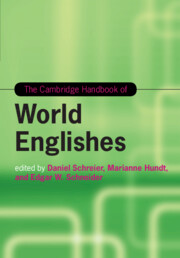Book contents
- The Cambridge Handbook of World Englishes
- Cambridge Handbooks in Language and Linguistics
- The Cambridge Handbook of World Englishes
- Copyright page
- Dedication
- Contents
- Figures
- Maps
- Tables
- Notes on Contributors
- 1 World Englishes: An Introduction
- Part I The Making of Englishes
- Part II World Englishes Old and New
- Part III Linguistics and World Englishes
- 14 The Global Growth of English at the Grassroots
- 15 Beyond English as a Second or Foreign Language: Local Uses and the Cultural Politics of Identification
- 16 World Englishes in Cyberspace
- 17 World Englishes and Their Dialect Roots
- 18 Lexicography and World Englishes
- 19 The Relevance of World Englishes for Variationist Sociolinguistics
- 20 Multilingualism and the World Englishes
- 21 Unearthing the Diachrony of World Englishes
- 22 Corpus-Based Approaches to World Englishes
- 23 World Englishes from the Perspective of Dialect Typology
- 24 Language Acquisition and World Englishes
- Part IV Current Challenges
- Index
- References
22 - Corpus-Based Approaches to World Englishes
from Part III - Linguistics and World Englishes
Published online by Cambridge University Press: 16 December 2019
- The Cambridge Handbook of World Englishes
- Cambridge Handbooks in Language and Linguistics
- The Cambridge Handbook of World Englishes
- Copyright page
- Dedication
- Contents
- Figures
- Maps
- Tables
- Notes on Contributors
- 1 World Englishes: An Introduction
- Part I The Making of Englishes
- Part II World Englishes Old and New
- Part III Linguistics and World Englishes
- 14 The Global Growth of English at the Grassroots
- 15 Beyond English as a Second or Foreign Language: Local Uses and the Cultural Politics of Identification
- 16 World Englishes in Cyberspace
- 17 World Englishes and Their Dialect Roots
- 18 Lexicography and World Englishes
- 19 The Relevance of World Englishes for Variationist Sociolinguistics
- 20 Multilingualism and the World Englishes
- 21 Unearthing the Diachrony of World Englishes
- 22 Corpus-Based Approaches to World Englishes
- 23 World Englishes from the Perspective of Dialect Typology
- 24 Language Acquisition and World Englishes
- Part IV Current Challenges
- Index
- References
Summary
The chapter provides an overview of the developments in synchronic and diachronic corpus-linguistic research into World Englishes (WEs), detailing methodological concerns such as sampling frames, representativeness, corpus size, and statistical modeling on the one hand and the broadening scope of corpus-based research from ENL to ESL and EFL varieties on the other hand. It also surveys areas in which corpus evidence has been applied in the study of WEs (e.g. as a testing bed for models of WEs, for the study of language contact, typology, and change or as a source of evidence for sociolinguistic and pragmatic variation), providing ample illustration from seminal research papers and recent studies in the field.
Keywords
- Type
- Chapter
- Information
- The Cambridge Handbook of World Englishes , pp. 506 - 533Publisher: Cambridge University PressPrint publication year: 2020
References
References
= Australian Corpus of English (Written Australian English, 1986)
= Web-derived 2006 Brown Corpus (Written American English, 2006)
= A Representative Corpus of Historical English Registers [www.helsinki.fi/varieng/CoRD/corpora/ARCHER/updated%20version/background.html#history]
= Before Brown Corpus (Written American English, 1930s)
= Web-derived 2006 LOB Corpus (Written British English, 2006)
= Before LOB Corpus (Written British English, 1930s)
= British National Corpus (Spoken and Written British English, 1991–1994; 2014) [www.natcorp.ox.ac.uk]
= Brown Corpus (Written American English, 1961)
= Corpus of Early New Zealand English (see Hundt 2012)
= Corpus of Late Modern English Texts [www.helsinki.fi/varieng/CoRD/corpora/CLMETEV/index.html]
= Corpus of Historical American English [https://corpus.byu.edu/coha/]
= Corpus of Early Ontario English (see Dollinger 2005)
= Corpus of Oz Early English (see Fritz 2007)
= Corpus of Irish English Correspondence (see McCafferty & Amador-Moreno 2012)
= Freiburg Brown Corpus (Written American English, 1992)
= Freiburg LOB Corpus (Written British English, 1991)
= Corpus of Global Web-based English (web-based corpus of World Englishes, approximately 1.9 million words) [www.english-corpora.org/glowbe/]
= International Corpus of English [www.ice-corpora.uzh.ch]
= International Corpus of Learner English (Corpus of argumentative essays from university learners of English as a foreign language, with various first language backgrounds) [https://uclouvain.be/en/research-institutes/ilc/cecl/icle.html]
= The Kolhapur Corpus of Indian English (Written Indian English, 1978)
= Louvain International Database of Spoken English Interlanguage (Spoken learner interview data, various first languages) [https://uclouvain.be/en/research-institutes/ilc/cecl/lindsei.html]
= London-Oslo-Bergen Corpus (Written British English, 1961)
= News on the Web (web-based monitor corpus of newspaper archives from twenty countries; since 2010) [www.english-corpora.org/now/]
= Strathy Corpus of Canadian English (spoken and written Canadian English, 50 million words; data from the early 1980s until 2010; available at BYU) [www.queensu.ca/strathy/corpus]
= Wellington Corpus of Written New Zealand English (Written New Zealand English, 1986)
Secondary Sources
- 1
- Cited by

